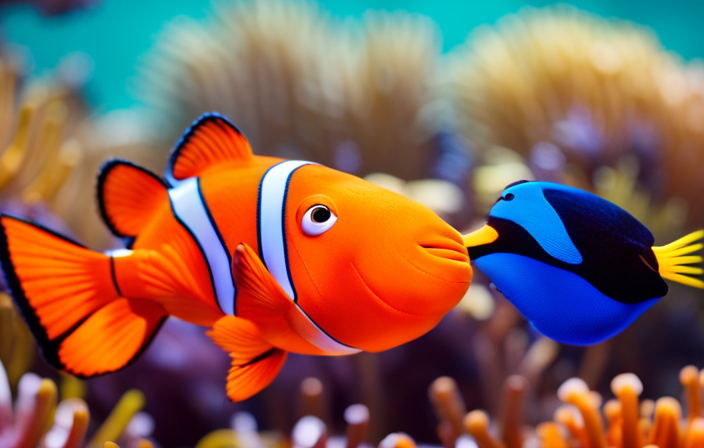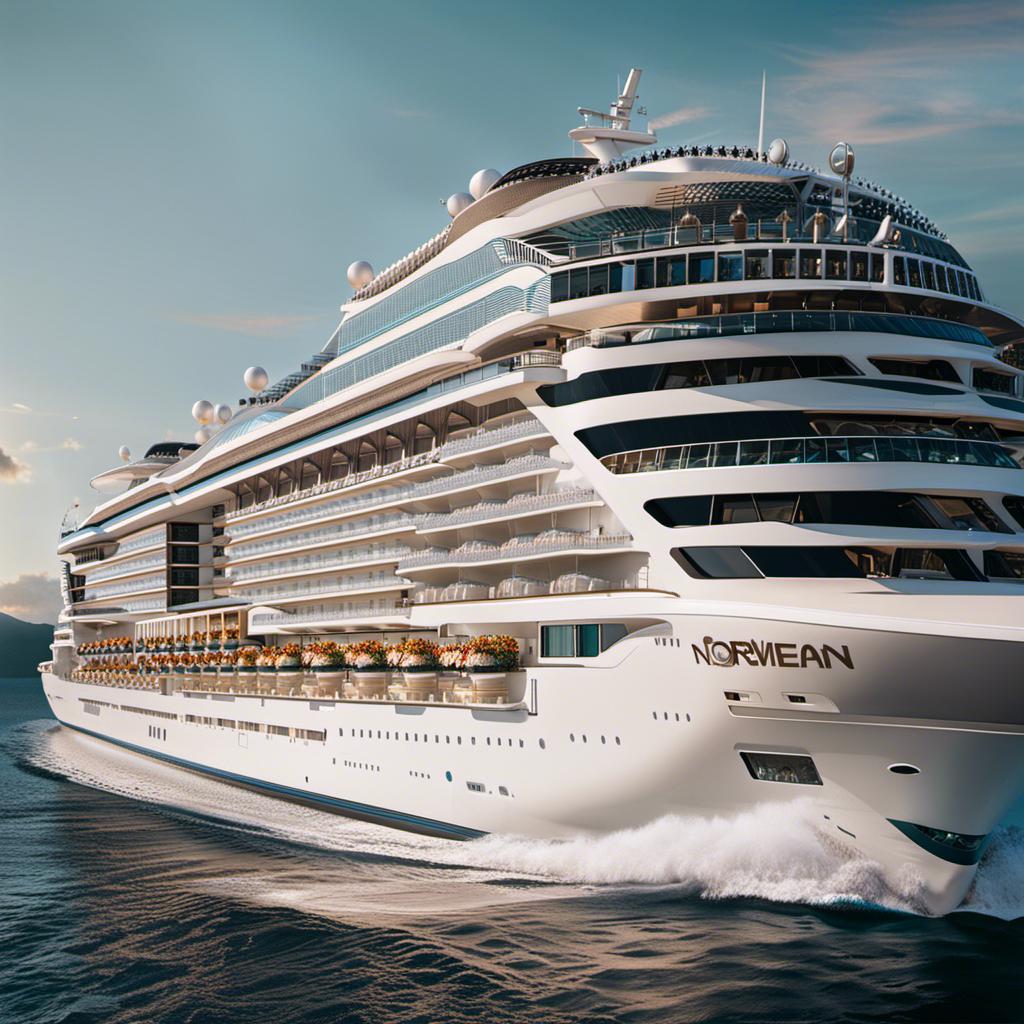As someone who deeply loves marine life, I found myself completely astonished by the diverse range of fish species showcased in ‘Finding Dory.’ From the sharp spines of Surgeonfish and Tangs to the remarkable smartness of octopuses, this film truly delves into the amazing variety present under the sea waves.
And who could forget the gentle giants like the whale shark and the beluga whale? With their immense size and unique adaptations, they never fail to leave us in awe.
Join me as we dive deep into the captivating world of ‘Finding Dory’ and discover the wonders of these extraordinary fish.
Key Takeaways
- Surgeonfish and tangs, including the Pacific Blue Tang (Dory), are found in shallow tropical reefs of the Indian and Pacific oceans.
- These fish species spawn in large groups and release their eggs into the water column, which then drift with the currents until they hatch into larvae.
- The larvae go through a pelagic phase in the open ocean before settling onto coral reefs.
- Overfishing, habitat destruction, and pollution are threats to the survival of surgeonfish and tangs, making conservation efforts crucial for their preservation.
Surgeonfish and Tangs
I’ve learned that surgeonfish and tangs, like the Pacific Blue Tang (Dory) and surgeonfish with tang-based aliases, can be found in shallow tropical reefs of the Indian and Pacific oceans.
Surgeonfish and tangs have fascinating breeding habits. They are known to spawn in large groups, releasing their eggs into the water column. These eggs then drift with the currents until they hatch into larvae. The larvae go through a pelagic phase, where they float in the open ocean, before eventually settling onto coral reefs. This complex reproductive process is crucial for the survival of these species.
However, surgeonfish and tangs are facing threats to their survival. Overfishing, habitat destruction, and pollution are some of the main challenges they face. It is important to protect their habitats and implement sustainable fishing practices to ensure the continued existence of surgeonfish and tangs in our oceans.
Pacific Blue Tang (Dory)
Swimming through the shallow tropical reefs of the Indian and Pacific oceans, the Pacific Blue Tang, also known as Dory, captivates with its vibrant colors. As a member of the surgeonfish family, the Pacific Blue Tang possesses a remarkable level of intelligence. It demonstrates complex behaviors, such as problem-solving and memory retention.
However, despite its popularity, breeding Pacific Blue Tang in captivity has proven to be a challenge. The delicate nature of their reproductive process, which involves external fertilization and the need for specific environmental conditions, makes it difficult to replicate in a controlled setting. Furthermore, the Pacific Blue Tang’s sensitivity to changes in water quality and diet makes it even more challenging to rear them successfully.
These obstacles highlight the importance of sustainable practices in the aquarium trade to ensure the conservation of this fascinating species.
Surgeonfish With Tang-Based Aliases
As I explore the world of surgeonfish, I am fascinated by the intriguing tang-based aliases that some of these species possess. Surgeonfish, commonly known as tangs, are found in shallow tropical reefs of the Indian and Pacific oceans. They are recognized for their vibrant colors and razor-sharp spines on their tails, which they use for self-defense. While breeding surgeonfish in tanks is not common, it is an area of interest for aquarists and researchers. Breeding surgeonfish in tanks can help reduce the pressure on wild populations and ensure the sustainability of these beautiful fish. To convey a deeper meaning, here is a table showcasing some surgeonfish species and their tang-based aliases:
| Species | Tang-Based Alias |
|---|---|
| Acanthurus coeruleus | Powder Blue Tang |
| Zebrasoma scopas | Brown Tang |
| Paracanthurus hepatus | Palette Surgeonfish |
| Naso lituratus | Orangespine Unicornfish |
Breeding surgeonfish in tanks is a promising avenue for conservation and research, allowing us to better understand these fascinating creatures while also protecting their wild populations.
Found in Shallow Tropical Reefs of Indian and Pacific Oceans
Exploring the world of surgeonfish, I am amazed by their presence in the shallow tropical reefs of the Indian and Pacific oceans. These vibrant and colorful fish play a crucial role in maintaining the health of coral reefs.
However, their populations are facing challenges due to the impact of tourism and human activities. The popularity of these reefs as tourist destinations has led to increased pressure on surgeonfish populations. Overfishing, destructive fishing practices, and habitat destruction have all contributed to the decline of these magnificent creatures.
Conservation efforts are now being implemented to protect surgeonfish and their ecosystems. Marine protected areas, fishing regulations, and public awareness campaigns are being used to educate people about the importance of preserving these fragile habitats.
It is crucial that we continue to work towards sustainable tourism practices and support the conservation efforts to ensure the survival of surgeonfish and the delicate balance of our oceans.
Razor-Sharp Spines on Tail for Self-Defense
I was startled when I learned that surgeonfish have razor-sharp spines on their tail for self-defense. These spines are not just for show, but serve as a formidable weapon against potential predators.
The presence of these spines provides surgeonfish with an evolutionary advantage by enhancing their chances of survival in the harsh and competitive underwater environment. When threatened, surgeonfish are able to swiftly maneuver their tail and inflict injury upon their attackers, deterring them from further pursuit.
This self-defense mechanism is a crucial component of their survival strategy, allowing them to protect themselves and escape potential harm. The razor-sharp spines on their tail are a testament to the remarkable adaptations that have evolved over time, enabling surgeonfish to thrive in their natural habitat.
Breeds in the Wild, Not in Tanks
Breeding surgeonfish in tanks is not a viable option as they are known to breed exclusively in the wild. This is due to the specific conditions required for successful breeding, which are difficult to replicate in captivity. Surgeonfish rely on complex environmental cues, such as water temperature, lighting, and the presence of other fish species, to trigger their breeding behavior. Captive environments often lack these crucial factors, resulting in low breeding success rates.
The impact of captivity on breeding success is a concern for conservation efforts aimed at maintaining wild breeding populations. By studying the natural breeding behaviors of surgeonfish in their native habitats, researchers can gain valuable insights into their reproductive biology. This knowledge can then be used to inform conservation strategies, such as creating protected marine areas and implementing sustainable fishing practices.
Impact of Popularity on Species
The popularity of surgeonfish and tangs in the aquarium trade has led to an increase in demand, which can have negative consequences for their wild populations.
As these colorful and charismatic fish are sought after by aquarium enthusiasts, the impact of tourism on their natural habitats becomes a pressing concern. Increased demand can result in overharvesting, habitat destruction, and the capture of wild individuals for the pet trade.
These activities can lead to population declines and even local extinctions of these species. To mitigate these negative effects, conservation efforts are being implemented. These include the establishment of marine protected areas, regulations on fishing and trade, and the promotion of sustainable alternatives such as captive breeding programs.
It is crucial that we balance the enjoyment of keeping surgeonfish and tangs in captivity with the preservation of their wild populations through responsible and sustainable practices.
Clownfish
Bred in captivity as a sustainable alternative, clownfish like Nemo and Marlin are popular choices for aquarium enthusiasts. These vibrant and iconic fish, also known as Ocellaris clownfish, are commonly found in sea anemones, specifically in the eastern parts of the Indian Ocean and western parts of the Pacific.
Here are four interesting facts about clownfish:
-
Breeding habits: Clownfish are sequential hermaphrodites, which means they have the ability to change their sex. The largest fish in a group, usually a female, will transform into a male if the dominant male dies or is removed from the group.
-
Conservation efforts: Due to their popularity, clownfish populations have been negatively impacted by overharvesting for the aquarium trade. As a result, conservation efforts have been implemented to ensure sustainable breeding practices and protect their natural habitats.
-
Mutualistic relationship: Clownfish have a unique relationship with sea anemones. They are immune to the stinging cells of the anemone and receive protection from predators in return. Additionally, clownfish help to attract prey to the anemone, providing it with a steady source of food.
-
Parental care: Clownfish are excellent parents. After the female lays her eggs on a flat surface near the anemone, the male guards and aerates them by fanning them with his fins. He also keeps them clean and removes any debris that may accumulate.
Through breeding programs and conservation efforts, we can ensure the continued presence of these beloved and fascinating clownfish in our aquariums and in their natural habitats.
Clownfish (Nemo)
Now that we’ve learned about the general characteristics of clownfish, let’s focus on one popular clownfish species: the Ocellaris clownfish, famously known as Nemo.
Ocellaris clownfish are found in sea anemones, which provide them with shelter and protection. These vibrant orange fish have a unique reproductive strategy called sequential hermaphroditism. They are protandrous hermaphrodites, which means they start their lives as males and can transition into females.
In a clownfish group, the largest and most dominant individual is the female, while the rest are males. If the female dies, the dominant male will change its gender to become the new female. Clownfish have a complex social structure, exhibiting hierarchical behavior within their groups.
They communicate through sounds, such as chirping and popping, and use body movements to establish territories and defend their homes. These fascinating behavioral patterns and reproductive methods contribute to the captivating nature of Nemo and his clownfish counterparts.
Bred in Captivity as Sustainable Alternative
I’ve learned that breeding clownfish in captivity is considered a sustainable alternative to overharvesting from the wild. Sustainable breeding practices and conservation efforts have been implemented to ensure the survival of clownfish populations.
By breeding clownfish in controlled environments, we can reduce the need to capture them from their natural habitats, thus minimizing the impact on their populations. Conservation organizations and aquariums have been actively involved in these efforts, working together to develop successful breeding programs.
These programs focus on maintaining the genetic diversity and health of the captive clownfish populations. By doing so, we can help protect these iconic and colorful reef dwellers while also educating the public about the importance of conservation and sustainable practices.
Ocellaris Clownfish Found in Sea Anemones
Swimming gracefully among the vibrant sea anemones, ocellaris clownfish are known for their unique symbiotic relationship with these delicate creatures.
Nemo, the famous ocellaris clownfish, forms a mutualistic bond with sea anemones. The clownfish receive protection from predators within the anemone’s stinging tentacles, while they provide food and nutrients to the anemone through their waste and leftover food. This relationship benefits both parties and is essential for the survival of the clownfish.
However, ocellaris clownfish populations face several threats. Habitat destruction, pollution, and overfishing are major concerns. Destruction of coral reefs, the natural habitat of clownfish and sea anemones, directly impacts their survival. Pollution from coastal development and climate change further exacerbates the decline.
Additionally, excessive collection for the aquarium trade has led to a significant decline in wild clownfish populations. It is crucial to protect their habitats and regulate their trade to ensure the survival of these fascinating creatures.
Habitat in Eastern Parts of Indian Ocean and Western Parts of Pacific
Living in the eastern parts of the Indian Ocean and western parts of the Pacific, ocellaris clownfish thrive in their unique and diverse habitats. These habitats, which include coral reefs and sea anemones, provide the perfect conditions for the clownfish to live and reproduce. However, these habitats are under threat due to the effects of climate change. Rising sea temperatures and ocean acidification are causing coral bleaching and the destruction of coral reefs, which are crucial for the survival of the ocellaris clownfish. Additionally, the habitat of the Pacific Blue Tangs, another species found in these regions, is also being affected by climate change. Conservation efforts are being made to protect the ocellaris clownfish and other marine species in these areas, including the establishment of marine protected areas and sustainable fishing practices. By taking action now, we can ensure the survival and conservation of these beautiful and important fish species for future generations.
| Effects of Climate Change | Conservation Efforts | Habitat of Pacific Blue Tangs |
|---|---|---|
| Rising sea temperatures | Marine protected areas | Shallow tropical reefs |
| Ocean acidification | Sustainable fishing | Indian and Pacific oceans |
| Coral bleaching | practices |
Overharvesting Dented Clownfish Populations
Overharvesting has significantly impacted the populations of clownfish, causing a decline in their numbers and threatening their survival. Clownfish, also known as Nemo, are found in the eastern parts of the Indian Ocean and the western parts of the Pacific. Their habitat includes sea anemones, where they form a symbiotic relationship.
However, due to their popularity in the aquarium trade, clownfish populations have been heavily targeted for capture. This overharvesting has had a detrimental impact on marine ecosystems as it disrupts the balance of these fragile environments.
Conservation efforts are being made to protect clownfish populations and their habitats. Sustainable alternatives, such as breeding clownfish in captivity, have been implemented to reduce the demand for wild-caught clownfish. By raising awareness and promoting responsible practices, we can help preserve the diversity and beauty of our marine ecosystems.
Nemo and Marlin as Ocellaris Clownfish
I absolutely love how Nemo and Marlin, as ocellaris clownfish, bring joy to people who watch their journey in the movie.
Nemo and Marlin’s journey highlights the importance of sustainable breeding for clownfish populations.
Ocellaris clownfish, also known as the false clownfish, are found in the eastern parts of the Indian Ocean and the western parts of the Pacific. These vibrant fish form a symbiotic relationship with sea anemones, seeking shelter and protection in their tentacles.
However, overharvesting has significantly impacted clownfish populations in the wild. Breeding ocellaris clownfish in captivity offers a sustainable alternative to protect and conserve their species.
Octopus
Hank, the octopus voiced by Ed O’Neill, demonstrates a range of personality traits including boldness, shyness, and passiveness.
The East Pacific red octopus, known scientifically as Octopus rubescens, is a fascinating creature with unique characteristics and behaviors. This species is typically found in the coastal waters of the eastern Pacific Ocean, ranging from Alaska to Baja California. The East Pacific red octopus is known for its ability to camouflage and blend seamlessly with its surroundings, allowing it to hide from predators or ambush prey. It displays remarkable intelligence, problem-solving skills, and adaptability.
However, the effects of overfishing on octopus populations are concerning. With increasing demand for octopus in the seafood industry, their populations are declining rapidly. This overexploitation threatens their survival and disrupts the delicate balance of marine ecosystems. It is crucial to implement sustainable fishing practices and protect these magnificent creatures to ensure their continued existence.
-
The East Pacific red octopus’s remarkable ability to change color and texture to match its environment evokes a sense of awe and wonder.
-
The display of intelligence and problem-solving skills by these octopuses elicits admiration and fascination.
-
The devastating effects of overfishing on octopus populations invoke a sense of urgency and the need for conservation efforts.
Frequently Asked Questions
What Are Some of the Surgeonfish and Tang-Based Aliases Mentioned in the Article?
Some of the surgeonfish and tang-based aliases mentioned in the article are the Pacific Blue Tang (Dory) and other surgeonfish with tang-based names. The popularity of these fish can have an impact on their species.
How Do Surgeonfish Defend Themselves With Their Razor-Sharp Spines?
Surgeonfish have razor-sharp spines on their tails for self-defense. They use these spines to deter predators and protect themselves. The sharp spines are a key adaptation that allows surgeonfish to thrive in coral reef ecosystems.
Why Do Surgeonfish and Tangs Breed in the Wild and Not in Tanks?
Surgeonfish and tangs breed in the wild and not in tanks due to their specific habitat requirements. Tank breeding may not provide the necessary conditions for successful reproduction. The popularity of these species can have an impact on their populations in the wild.
What Is the Impact of the Popularity of Surgeonfish and Tangs on Their Species?
The impact of the popularity of surgeonfish and tangs on their species is significant. Conservation efforts are crucial to protect their populations and ensure their survival in the wild.
Can You Provide More Information About the Personality Traits and Defense Mechanisms of the East Pacific Red Octopus (Hank)?
The east Pacific red octopus, Hank, possesses a range of personality traits including boldness, shyness, and passiveness. His defense mechanisms involve ink squirting and attack mode when threatened. The popularity of surgeonfish and tang species impacts their survival.










